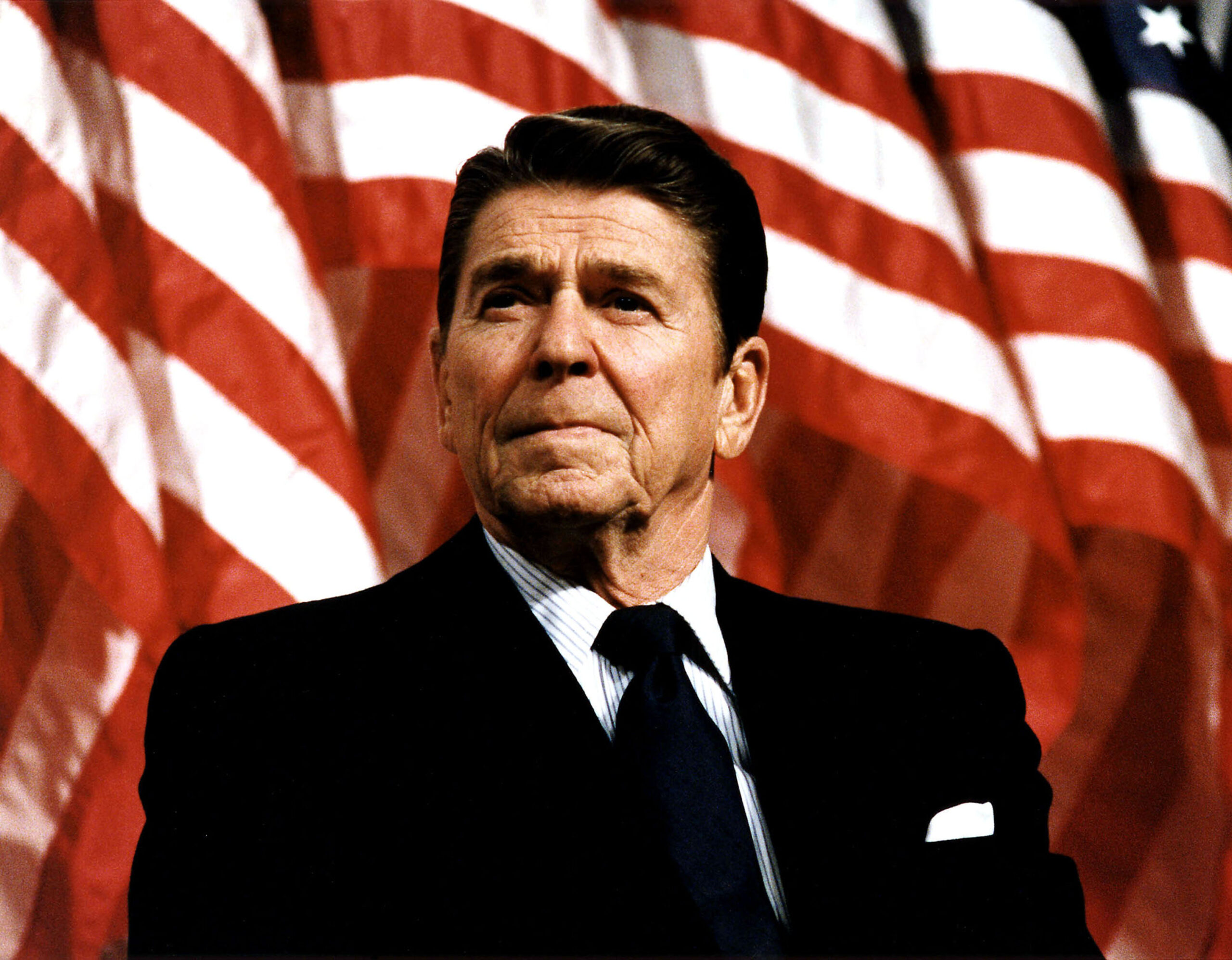Reconsidering Reagan: Racism, Republicans, and the Road to Trump
By Daniel S. Lucks
(Beacon Press, 2020)
Reaganland: America’s Right Turn, 1976–1980
By Rick Perlstein
(Simon and Schuster, 2020)
The election of Donald J. Trump to the White House unleashed a torrent of new histories of the conservative movement. Most such books explain Trump’s “conservatism” as a product of the same movement that produced Barry Goldwater, William F. Buckley, and Ronald Reagan. According to their authors, the thread that holds the conservative movement together is racism. As Daniel Lucks puts it in Reconsidering Reagan: Trump is “the product of a long progression that began back in 1964, when Reagan delivered his iconic ‘A Time for Choosing’ speech and the party of Lincoln nominated Barry Goldwater as their presidential nominee, and when the conservative movement rose to power in part by exploiting whites’ racial anxieties.”
Yet while Reconsidering Reagan embraces racism as the central explanation for conservatism’s success, Rick Perlstein’s Reaganland presents a more nuanced and contextual interpretation. Neither writer is a friend of the conservative movement, but Perlstein does a better job empathizing with his subject. Lucks’s book thus marks a shift in the historiography of the conservative movement. From the late 1990s until the last few years, historians had taken conservative ideas at least somewhat seriously and attempted to understand their subjects on their own terms. This more contextual approach seems to have fallen out of vogue, and the study of conservatism has become almost entirely partisan.
In Reconsidering Reagan, Lucks sets out to challenge what he views as the right-wing myth of Reagan by analyzing the fortieth president’s views and policies on civil rights. According to Lucks, Reagan should be viewed as a racist, or at best as a racially insensitive political opportunist who turned his back on “the racial liberalism of his youth by cozying up to George Wallace supporters.”
Perlstein is more cautious. He does not explicitly call Reagan a racist and attempts to understand Reagan’s motivations for appealing to racist white voters. Reaganland is the culmination of Perlstein’s four-volume history of the rise of the conservative movement, and the book contains a massive 914 pages of narrative. Whereas Lucks covers more than fifty years in a fourth of the space, Perlstein discusses events only from 1976 to 1980. The result is filled with details—some fascinating and some less so—and often wanders from topic to topic with little to hold it together other than chronology.
The difference between Perlstein’s and Lucks’s approaches can be demonstrated by an event that both chronicle: Reagan’s 1980 general election campaign speech at the Neshoba County Fair near Philadelphia, Mississippi, a place where three civil rights workers had been murdered in 1964. This episode has long been used by progressive historians and activists to claim that Reagan was elected in 1980 by “dog-whistling Dixie.” Lucks agrees, noting that Reagan traveled to the fair accompanied by a former segregationist to address an all-white crowd waving Confederate flags.
The only part of Reagan’s speech that Lucks quotes is the infamous “I believe in states’ rights” line, followed by Reagan’s obvious racial appeal (according to Lucks) to “restore to states and local governments the power that properly belongs to them.” Lucks argues that this visit was designed to help Reagan appeal to “George Wallace inclined voters.” Lucks goes on to mention, multiple times, that the Ku Klux Klan endorsed Reagan, but fails to mention Reagan’s forceful denunciation of those endorsements. This is the trend for Lucks, who also insinuates that Reagan might have been a member of the John Birch Society despite the fact that in 1966 Reagan emphatically declared: “I am not a member. I have no intention of becoming a member. I am not going to solicit their support.”
Lucks’s treatment of Reagan’s trip to the Neshoba County Fair is emblematic of the way he portrays Reagan throughout the book. Reagan’s comments are taken out of context, and Lucks quotes Reagan’s political enemies to confirm his own interpretation of events. Lucks is not interested in context, so he never mentions that George Wallace cut radio campaign commercials for President Jimmy Carter in 1976 and endorsed him again in 1980. Lucks also fails to mention that Carter campaigned across the South with former segregationists such as Jim Eastland and John Stennis—who both signed the so-called Southern Manifesto of 1956. The reality is that both Reagan and Carter were interested in Wallace supporters.
It also is not clear that Reagan’s alleged appeal did him any good. Those on the ground in Mississippi believed the controversy over Reagan’s comments at the Neshoba County Fair combined with incorrect statements about Tuscumbia, Alabama, being the birthplace of the KKK had hurt him in the polls. This runs counter to Lucks’s claim that “Reagan’s Southern outreach was reaping dividends.”
Perlstein presents a more balanced interpretation of the Neshoba controversy and draws on my own archival research about the 1980 campaign in the South. He correctly provides the context for Reagan’s visit: Ford barely lost Mississippi in 1976, and the state looked like a possible pickup for Republicans. Perlstein then notes that Reagan did not generally use the phrase “states’ rights” and had to be convinced to include the phrase by then-Congressman Trent Lott. Throughout, Perlstein gives Reagan the benefit of the doubt, suggesting that Reagan convinced himself that by uttering the phrase “he was referring to all federal intrusion into local affairs . . . the same thing he had always excoriated.” Perlstein concludes the scene by quoting a Mississippi Reagan supporter who wrote that Reagan’s speech hurt the candidate: “Three weeks ago Reagan had a landslide victory in Mississippi. Today it is a toss-up.”
Yet both Perlstein and Lucks act as if attending the Neshoba County Fair was Reagan’s idea. It was not. In fact, the Neshoba County GOP chairman, Pete Perry, requested that all the GOP primary hopefuls commit to attending the fair. Reagan was the last to do so. This also may explain why there was a scheduling conflict between the Neshoba visit and Reagan’s appearance at the Urban League, which was supposed to be his first campaign event.
Reduced to Racism
The differences in Perlstein’s and Lucks’s treatments of the Neshoba scene reflects the differences in their approach to sources. Both draw on the black press, which was very critical of Reagan, and both cite President Carter’s rebuke of Reagan and his attempt to cast Reagan’s comments as racist. Yet Lucks presents only these views and then condemns the press for letting Reagan off the hook. Perlstein does better. He presents various potential interpretations of the events and provides his readers with a more nuanced, and accurate, view of Reagan’s speech.
Another example of how Perlstein and Lucks differ is in their explanation of the 1970s New Right, specifically the rise of the Religious Right. Perlstein clearly does not like the New Right, but he goes to great lengths to document its activism. It must also be said that he allows them to explain, in their own words, why they believed the things they believed. In contrast, Lucks reduces the New Right to racism. Describing Falwell’s foray into politics, Lucks asserts that Falwell “was motivated in large part by opposition to the desegregation King championed.” While it is true that the IRS’s revocation of some private Christian academies’ tax-exempt status riled up evangelical conservatives, Lucks treats race as a totalizing factor.
This is the overarching problem with Lucks’s book: everything can be attributed to race and as such he concludes that racism is the cornerstone of the conservative movement. While neither Perlstein nor Lucks takes conservative ideas seriously enough to cite thinkers such as F. A. Hayek or Milton Friedman, Lucks is the worse abuser. The one time that Lucks attempts to engage with a conservative intellectual, Russell Kirk, he portrays Kirk as a southern sympathizer whose work is “replete with paeans to the Old South” but who never addressed the issue of slavery. In fact, Kirk was a northern agrarian, whose general opinion of the Civil War was pro-Lincoln and pro-Union, and who believed the goal of the civil rights movement was just, even if he disagreed with what he considered its more radical elements.
It seems never to have dawned on Lucks that Reagan’s views on political economy might have provided a better explanation for his opposition to the 1964 Civil Rights Act or the 1965 Voting Rights Act than outright racism. According to Lucks, such reasoning simply provided a guise for racist policies and opinions. In Lucks’s view, there was no credible reason to oppose busing, to support welfare reform, to be fearful of a growing federal government, or to support local control.
To be fair, Lucks does touch on important topics and is absolutely correct that Reagan’s record on race is part of his legacy. In addition to his opposition to the Civil Rights and Voting Rights Acts, Lucks documents some of Reagan’s worst moments, including his violation of academic freedom and other civil liberties while governor of California and his perpetuation and expansion of the War on Drugs. The problem is that one never really knows whether to trust Lucks, since readers are never presented both sides of the story. Overt partisanship destroys his credibility as a historian. This really is a pity, because Republicans do have a race problem—but not the one Lucks thinks. Exploring the interconnectedness of fiscally conservative views on political economy and conservatives’ inability to confront systemic racism would have been a worthwhile endeavor.
In many ways, these books have opposite defects. Lucks offers opinions masquerading as analysis, rarely allows conservatives to speak for themselves, and provides little to no historical context. Conservatives, or just fair-minded readers, will find Lucks’s depiction of Reagan infuriating, but he definitely has an argument. Perlstein suffers from the opposite problem. Reaganland is filled with historical trivia discussed in detail but never really connected by the author’s analysis. Perlstein fails to provide a clear argument and does little to make sense of the four years he discusses in granular detail.
As a result, both books will feel foreign to conservative readers. I cannot recommend either—at least not without a more balanced book to serve as a corrective. Reagan and his legacy continue to be important to our political discourse. In the process of trying to dispel conservatives’ mythical conception of Reagan, Lucks has embraced the progressive myth that simplifies Reagan as a racist and places the credit for the success of the conservative movement on racist appeals. As for Perlstein, it looks as though the press rushed Reaganland to publication before the 2020 election. The result is filled with typographical and factual errors and lacks a central argument to tie the behemoth of a volume together.
The fight over historical interpretation of Reagan continues, but it has taken a step backward over the past few years. Instead of taking ideas seriously, trying to understand different strands of conservatism and attempting to provide nuanced explanations that draw on historical context, progressive historians are struggling to explain how more than seventy-four million Americans could have voted last year for a president they believe to be an irremediable authoritarian and racist. This cognitive turmoil is manifesting itself through the historiography of conservatism. Concluding that racism can explain conservative success may be a comforting explanation for the left, but it is not likely to result in understanding. One longs for a day when contemporary politics and one’s party affiliation will not determine a historian’s analysis.
Marcus M. Witcher is an assistant professor of history at Huntingdon College and the author of Getting Right with Reagan: The Struggle for True Conservatism, 1980–2016.














